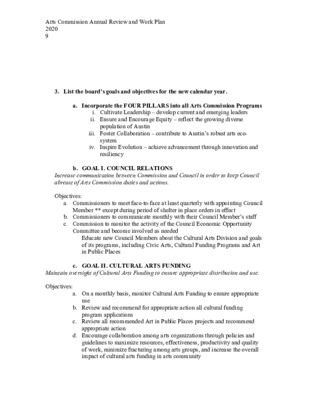Arts Commission Work Plan for 2020 — original pdf
Backup

Arts Commission Annual Review and Work Plan 2020 9 3. List the board’s goals and objectives for the new calendar year. a. Incorporate the FOUR PILLARS into all Arts Commission Programs i. Cultivate Leadership – develop current and emerging leaders ii. Ensure and Encourage Equity – reflect the growing diverse population of Austin iii. Foster Collaboration – contribute to Austin’s robust arts eco- iv. system Inspire Evolution – achieve advancement through innovation and resiliency b. GOAL I. COUNCIL RELATIONS Increase communication between Commission and Council in order to keep Council abreast of Arts Commission duties and actions. Objectives: a. Commissioners to meet face-to-face at least quarterly with appointing Council Member ** except during period of shelter in place orders in effect b. Commissioners to communicate monthly with their Council Member’s staff c. Commission to monitor the activity of the Council Economic Opportunity Committee and become involved as needed Educate new Council Members about the Cultural Arts Division and goals of its programs, including Civic Arts, Cultural Funding Programs and Art in Public Places c. GOAL II. CULTURAL ARTS FUNDING Maintain oversight of Cultural Arts Funding to ensure appropriate distribution and use. Objectives: use a. On a monthly basis, monitor Cultural Arts Funding to ensure appropriate b. Review and recommend for appropriate action all cultural funding program applications appropriate action c. Review all recommended Art in Public Places projects and recommend d. Encourage collaboration among arts organizations through policies and guidelines to maximize resources, effectiveness, productivity and quality of work, minimize fracturing among arts groups, and increase the overall impact of cultural arts funding in arts community Arts Commission Annual Review and Work Plan 2020 10 e. Review funding program guidelines annually and revise as needed. d. GOAL III. PUBLIC ART Maintain support for the Art in Public Places program Objectives: a. staff or the Art in Public Places Panel b. Commission and the Art in Public Places Panel On a monthly basis, take action on project or program recommendations from Build a strong framework of understanding and communication between the Arts e. GOAL IV. ROLES AND RESPONSIBILITIES Maintain a robust working knowledge and understanding of the role and responsibilities of the Arts Commission by all Commissioners Objectives: a. Orient any newly appointed Commissioners on the role of the Arts Commission through the use of the Arts Commission orientation document upon appointment b. Conduct an annual Arts Commission all-day retreat c. Review goals quarterly to track progress f. GOAL V. LIAISON GROUPS, BOARDS AND COMMISSIONS Ensure appropriate representation and working relationship with all Liaison groups and other related Boards and Commissions through meeting attendance and presentations Objectives: a. Select representatives to serve on the following groups: i. Art in Public Places Panel ii. Downtown Commission iii. Other working groups and assignments as needed b. Build and maintain a stronger working relationship with Arts in Public Places Panel, Music Commission and other Liaison groups c. Each Commissioner will attend a related Boards & Commissions regular meeting, (i.e. Music Commission, Library, African American Quality of Life, etc.) at least once per year. g. GOAL VI. CULTURAL CONTRACTORS Maintain a strong relationship and understanding of all Cultural contractors Objectives: a. Each Commissioner will attend a minimum of 12 cultural contractor performances/exhibits per year b. Each Commissioner will attend a minimum of 1 Art in Public Places project dedication per year Arts Commission Annual Review and Work Plan 2020 11 h. GOAL VII. COMMUNITY RELATIONS AND ENGAGEMENT Maintain a strong working relationship and increase engagement with local arts organizations and communities – especially historically underserved (BIPOC) and marginalized (including LGBTQ and Disability) communities. Objectives: a. Increase communications about upcoming Commission meetings and cultural arts funding. b. Establish better working relationships with various arts organizations around Austin including ACA, AMP, and Big Medium (others) by regular outreach and communication through social media and other means c. Each Commissioner to invite at least 2 cultural contractors or new arts organization to attend and present at a regular Commission meeting d. Conduct special outreach to historically underserved (BIPOC) and marginalized (including LGBTQ and Disability) Communities about opportunities and funding available through the Cultural Arts Division i. GOAL VIII. ISSUES AND ADVOCACY Advocate on behalf of Arts constituents and increase their awareness of the function and role of the Arts Commission and of the importance of their own participation and engagement. Objectives: a. Increase our understanding of the pulse of the arts community’s needs and issues by attending community events b. Raise awareness and increase communication with constituents through social media and face-to-face networking about issues before the Commission and City Council related to the Arts. c. Encourage participation of all arts groups and communities on issues before the Commission and Council on an ongoing basis. d. Bring concerns of the arts community before Council through appropriate actions and communications e. Address issues facing the arts communities including but not limited to affordability, transportation, quality of life, and venue preservation and propose comprehensive recommendations for solutions and actions to Council f. Seek funding for continuation of the Arts Space Assistance Program j. GOAL IX. DISTRICT ENGAGEMENT Deepen Relationship and responsiveness to representative districts Objectives: a. Continue to propose suggestions for community outreach and inclusion aimed at making meetings more accessible and vital to the districts represented Arts Commission Annual Review and Work Plan 2020 12 c. Track and analyze the projects/artists funded by district as well as other demographics such as race, gender and sexual identity to best ensure equitable distribution of funding, projects, and programming throughout the districts to the extent possible.